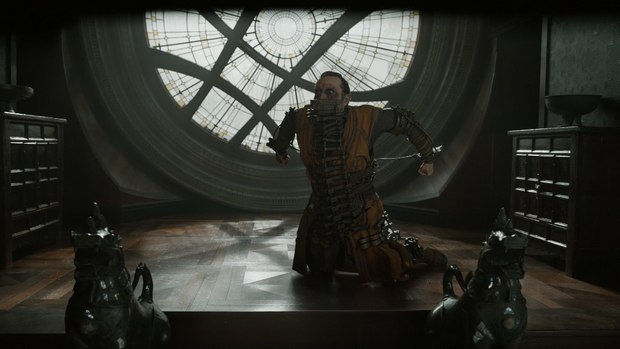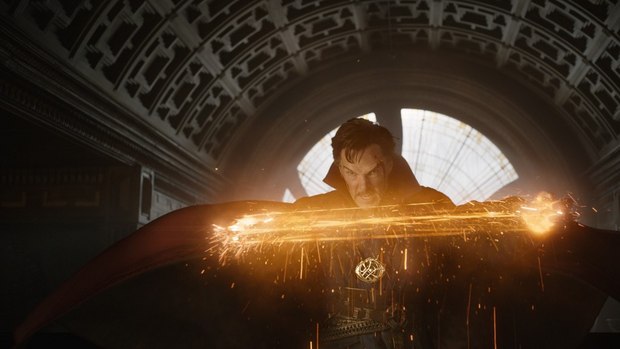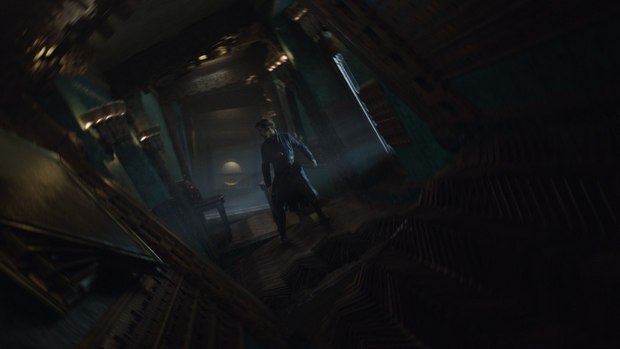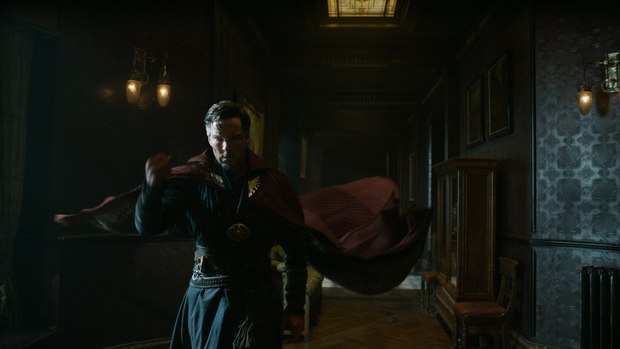Framestore provides more than 365 shots for the Marvel Studios blockbuster directed by Scott Derrickson, with work spanning CG environments and complex ‘Mandlebrot’ sets, digi-doubles of key characters, and the creation of Doctor Strange’s astral form used throughout the film.
Marvel’s latest comic book hero to receive the big-screen treatment is Doctor Strange. The creation of artist Steve Ditko, Strange (played by Benedict Cumberbatch) is a master of “black magic,” armed with magical objects and a cloak with a mind of its own, operating from his Sanctum Sanctorum, a Greenwich Village townhouse in New York City. Framestore was brought on board to help the filmmakers decide how to visualize Doctor Strange’s odd, mystical abilities throughout the movie. “Doctor Strange is the master of the dark arts; it’s unconventional and quite psychedelic but very visually interesting,” says VFX supervisor Mark Wilson. “The old-school fans will really appreciate it, and people who aren’t too familiar with Doctor Strange will enjoy the visual feast.”
Unlike many previously existing comic book heroes and villains, such as Doctor Fate and Doctor Doom, Strange is literally and authentically a doctor. Stephen Strange is a brilliant surgeon, whose career unwittingly comes to an end following a tragic accident. Unwilling to accept that his life must change, Stephen becomes obsessed with healing himself. Finding no solution in science, he travels the world and investigates whisperings of magic that might bring him relief. His journey brings him to the temple of the Ancient One (Tilda Swinton), where his meddlings with magic begin.
Framestore worked on more than 365 shots between October 2015 and September 2016, encapsulating a range of VFX and animation work that spanned environments, the complex “Mandlebrotting” of sets, incredibly high-resolution digi-doubles of key characters and the creation of the astral form, a key technique used throughout the film.
Doctor Strange uses Eldritch magic to battle his nemeses, who include Kaecilius (Mads Mikkelsen) and a “Zealot” army. The magic is light-based, producing sparks and energy, and uses a fiery yellow/orange color palette throughout. “As with any form of magic, the complexity of the effect came from how subjective the look is and how much we wanted it to look real,” states CG supervisor Alexis Wajsbrot. “When we started on the effect, the first concept used long-exposure photography. The reference was a streak of light from Strange and his magical whip; the sparks were also long, creating a curved flare which you can’t generate without CG. It just ended up looking too fantastical; so we kept making the effects shorter.”
Helpfully, LED lights were used on set around Doctor Strange’s whip and his gateway (which transports him to different locations) to give lighting references as to how the sparks would affect the background environment. Using a CG set-up in Houdini, the team was able to control the length, curvature and intensity of each spark, creating the desired look in each shot.
Space Shards
A particular challenge for the compositing team was the developing and propagating the look of the Space Shard effect seen throughout the Sanctum attack sequence. “The space shards were created using a combination of CG animated trails whose motion vectors were treated in comp to give us an interesting distortion for fast moving weapons,” explained Compositing supervisor Oliver Armstrong. “A system created using Nuke’s particle tools was also used to generate slower, flowing distortions for the more static shots.”
The Mandlebrot sets within the film are dream-like, kaleidoscopic interior shots which fold the environments, pulling them apart and re-configuring in complicated patterns around the characters. “The effect was quite difficult to nail down, as to how far we should go with it,” says Wilson. “Especially when our live-action characters had to be integrated within those scenes.”
Because of the quantity of movement within the whole set, nearly everything needed to be animated; even if the team didn’t strictly need to animate a prop, they had to make it available to the animators in case certain surrounding elements within the scene needed to move in a different way. Led by animation supervisor Nathan McConnell a new pipeline was introduced to set up the animation team with a rigging tool of their own. “We designed a new workflow to create a toolbox for the animator, incorporating all of the levels of movement and pivots,” McConnell says. “The animators were able to rig everything themselves, and had the power to duplicate the geometry if needed.”
“There’s the whole set bending and molding, cloning and reconfiguring itself, but then there’s also the Mandelbrot pattern, which is the mathematical formula that creates these crazy patterns and the fractured world aspect to it,” Wilson adds. “Once we had animated all of these assets, our FX team then placed additional Mandelbrot sponge fractal patterns inside it, using Houdini to drive a proprietary Arnold procedural iso surface shader at render time to give us a mathematical organic growth that was really cool. That was all new to us!”
Framestore shader writer Josh Bainbridge was principally involved in the execution of the Mandelbrot shader. “Due to the complexity of the Mandelbrot geometry and detail required, we decided to extend Arnold to allow for intersection of arbitrary iso surfaces,” Bainbridge explains. “What this meant was that a mathematical function could be chosen to define a shape, and then a ray marching technique called ‘near distance estimation’ was used to find the intersection along a ray. This allowed us to render a range of very complex and detailed structures (including the Mandelbrot fractal), without storing or looking up any volume data. It also seamlessly integrated the lighting and shading of the surfaces into our physically based rendering system. Our solution involved every iso surface being confined to the space of a particular polygonal object. Attached to this object would be information on the mathematical function and its parameters to be used when rendering the surface. This allowed effects artists to change parameters for each object individually, and combine different iso surfaces in one scene. We then used the same polygonal object to gather other information such as texture parametrization, which allowed us to lookdev and light the fractals like any other asset.”
One of Doctor Strange’s powers is that he can exist in another plane -- what the Marvel world calls the “astral plane,” home of his “astral form.” However, when Strange is in his astral form, he can still be in the real world although not visible to humans. It’s fairly established in the comics, but was a challenge for Framestore to digitalize how that should look. “It was one of the hardest effects we’ve had to deal with at Framestore,” says Wajsbrot, “finding the right balance of a look that was subtle but also beautiful.”
VFX supervisor Jonathan Fawkner led the work on the astral projection scenes. It became clear early on that with Strange in a semi-transparent form, the background would play a crucial role. In every single shot the team therefore needed to rack the amount of transparency and the tools to make it feel as though Strange was transparent but still visible, using subtle tricks to keep the transparency coherent.
“In the end we back-lit everything,” Fawkner recounts. “When our characters were back-lit, you actually got a lot of negative space, which the eye perceives as contrast. It just so happens that when the character is transparent, the eye interprets both what is behind and that lack of detail at the same time. On top of that we had the FX team drive a particle system that gave the characters a slightly twinkly patina.”
It wasn’t just a case of making the characters transparent, however. Extremely high resolution CG digi-doubles were used to cut back-to-back with plate, which had to be graded so that it followed the lighting principles established for the astral form effect. Because the characters are able to fly, the team also had to find a level of gravitation that made them look naturally airborne, without encroaching on zero gravity effect. They also needed to illuminate our world. “Strange is meant to be a source of light when he is in astral form,” Wajsbrot adds. “We were always imitating some kind of aura around him, a volumetric emission from his clothes and skin in the same color, which we controlled in compositing.”
At one point in the film, Strange is in his astral form and has to make himself visible to people in the real world to instruct a surgeon who is performing a complicated surgery. Framestore named it the “semi-astral” state. “We had Strange emerge from a glassy, fractured portal,” explains Fawkner. “They did shoot Benedict on set but we had to adapt his body in some shots, providing CG arms and adjusting his position using our digi-double.” This semi-astral form was less luminous and very slightly more dense: “It was always just a case of perception. How transparent do we make it? It was a lot of trial and error.”
Marvel fans will be keen to see a central character brought to life in the film: that of Strange’s Cloak of Levitation. Worn by Strange, it is a fully-formed character with its own personality, which often flies around unaccompanied.
The first step was to model the cloak and provide a sophisticated cloth simulation. “We use N-cloth at Framestore, but we needed to enhance our method with the cloak,” Wajsbrot says. “We used the Marvelous Designer program which models cloth based on a real pattern. We worked closely with the costume department on-set, in order to get the measurement and patterns of the cloak and cloth for every character. We had a very dedicated modelling team led by Nicolas Leblanc who were all passionate about taking the cloth to the next level. Doctor Strange’s costume was made out of more than a hundred patterns. We also groomed cloth fibers on the cloak to give it that added level of detail.”
In many of the shots where Strange is wearing his magical cloak he was shot wearing real collar and shoulder sections of the costume cloak which had to be blended seamlessly with the animated CG. This was a tough process beginning with Framestore’s Paint and Roto department who tirelessly removed any excess parts of the costume before the Compositors could blend to the CG. Extreme care was taken to maintain the levels of haze and smoke present in the interior shots and ensure any motion in the blended area was a perfect match.
The team were keen to give the cloak its own personality in the animation, without looking too cartoony; finding the right balance between being animated and maintaining realism with simulation. “Normally if we were making a CG cloak we would just simulate the cloth,” says Wilson, “But this cloak needed to be directed; it is its own character. So the animators animating the cloak could see simplified dynamics in their scene to get a good representation of it.” After animation, the CFX department started work on the dynamics of the cloak to ensure that the desired levels of realism and gravity were achieved.
 As well as key sequences and effects, Framestore also worked on the Crimson Bands of Cyttorak, a harness used by Strange to restrain Kaecilius; the Space Shard effect used by the Zealots; and the Space Portal. 2.5D environments were also created for shots on Mount Everest, a NYC hospital skyline, exteriors shots of Strange’s Sanctum and the Rotunda of Windows scene, which saw Framestore work on no fewer than six environments, two of which were completely CG.
As well as key sequences and effects, Framestore also worked on the Crimson Bands of Cyttorak, a harness used by Strange to restrain Kaecilius; the Space Shard effect used by the Zealots; and the Space Portal. 2.5D environments were also created for shots on Mount Everest, a NYC hospital skyline, exteriors shots of Strange’s Sanctum and the Rotunda of Windows scene, which saw Framestore work on no fewer than six environments, two of which were completely CG.
With so many varied effects challenges and worlds to conjure, Framestore was delighted to help discover how Strange’s world worked. “As the film went on, we got a real feel for the world that Doctor Strange is living in, and the effects started to flow,” Wilson says.
The film’s imagery and storyline belong in Marvel’s world, but the tone is unique in its use of magic and dark arts, illusion and mystery -- fascinating elements which made it a joy and new challenge for the Framestore team. The approach to making the film, however, was the same as always: collaborate, and work at it until it is as good as it can be.
Source: Framestore














